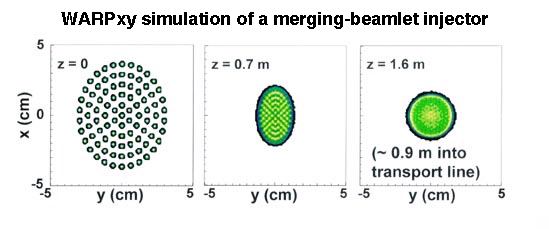Beam-Injector Experiments
Over the next two years, the HIF-VNL will carry out a series of experiments with high-current-density sources that could lead to brighter, more durable, and more compact injectors. The two source geometries now being studied are large-area sources and compact sources that merge many small beamlets into a larger beam. There are several key scientific issues that affect the choice between these two geometries:
- Understanding the causes of emittance growth for large-source and merged-beam injectors.
- Determining the maximum achievable current density for both approaches
- Studying the limits for high-gradient insulators and vacuum-gap voltage breakdown.
- Producing beams with sufficiently short rise times while minimizing beam mismatch.
Beam merging will be studied in scaled experiments on the STS-500 facilitity, a 500 kV test stand currently under construction at Lawrence Livermore National Laboratory. An existing test stand, the 100kV STS-100, will be used in parallel to develop ion sources. A variety of sources will be tested and characterized for both injection geometries, with surface-ionization sources being studied first, followed by plasma sources.
In addition to source development, the STS-500 facility will be used during the next several years to study electrostatic interactions in multiple-beam bundles, beam-gas interactions in long-duration pulses, and advanced accelerator concepts using very high voltage gradients. The experiments on multiple-beam effects are important for driver-scale accelerators because repulsion between beams within accelerator gaps is expected to affect beam centering.

For comments or questions contact WMSharp@lbl.gov or DPGrote@lbl.gov. Work described here was supported by the Office of Fusion Energy at the US Department of Energy under contracts DE-AC03-76SF00098 and W-7405-ENG-48. This document was last revised June, 2002.
